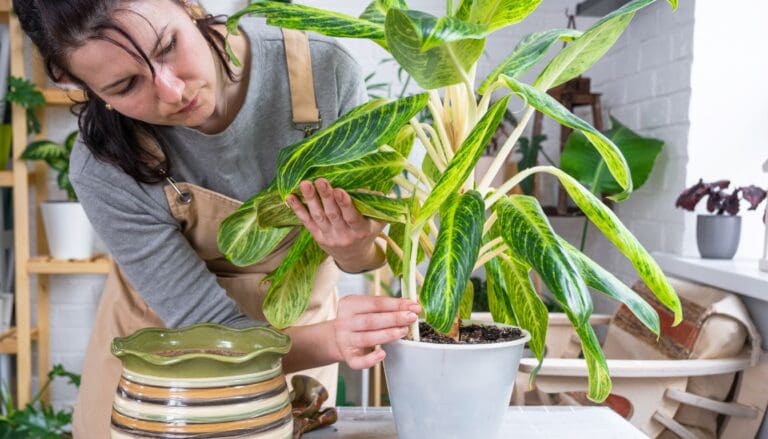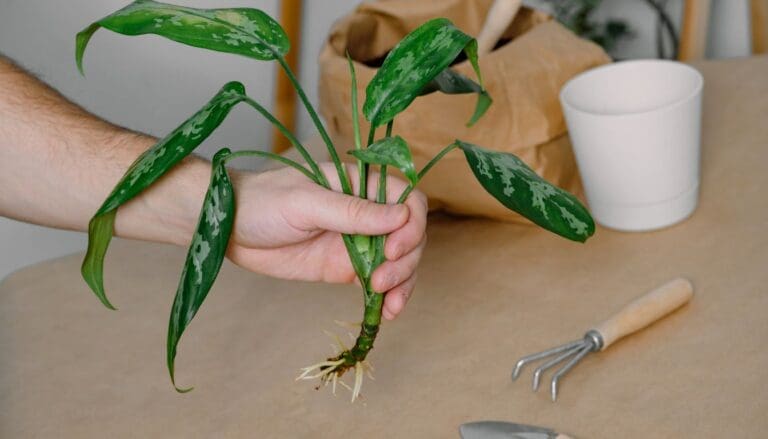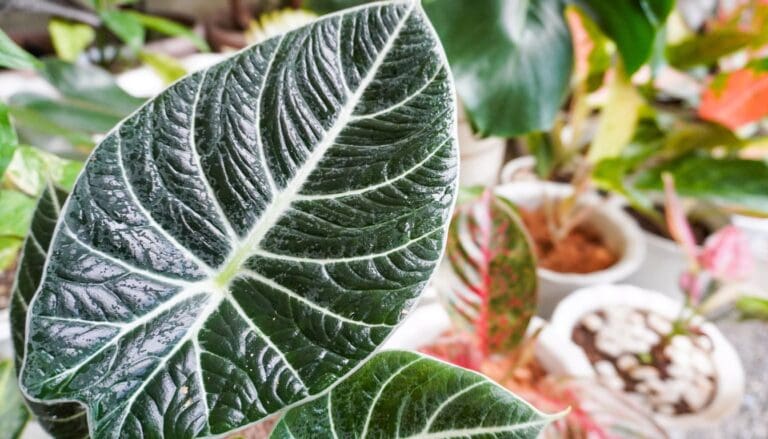Why Is My String Of Pearls Wrinkled? (Causes+What To Do)
The string of pearls requires adequate water to thrive. If the string of pearls doesn’t get enough water, it will start developing problems. It can also lead to the leaves wrinkling in your string of pearls.
There can be several other issues that cause the leaves to wrinkle in the string of pearls plant. So, in this article, we shall discuss why your string of pearls is wrinkled? Let’s find out!
Inadequate watering is the primary cause of wrinkles in a string of pearls. The leaves wrinkle because of dehydration in the plant or due to overwatering. Apart from that, using an inappropriate soil mix, low humidity, and damage during repotting can also lead to wrinkles in the string of pearls.
Problem with watering is not uncommon with a string of pearls. Understanding the water requirements might be a tricky task initially but learning it is not that difficult.
Let’s address all the problems that make the leaves wrinkled.

Please note: Simplify Plants is reader-supported. Some links in the post are affiliate links and I get a commission from purchases made through links in the post.
What causes string of pearls plant leaves to wrinkle?
There can be several causes of wrinkles in a string of pearls. Some of the common ones are:
- Watering issue
- Lighting conditions
- Temperature and humidity
- Potting soil
- Size of the pot
- Season
- Shock
Let’s discuss the topics in detail to help you identify what is wrong with the plant and find out why the leaves wrinkle in your string of pearls plant.
Watering issue

There can be two problems related to watering. One is overwatering, and the other is underwatering.
Both the situations are unfavorable for the string of pearls. Let’s understand how.
Overwatering
Overwatering is prevalent in the string of pearls plant. Since this plant is succulent, it requires less water than most other plants and can even survive droughts.
The string of pearls stores water in its leaves and doesn’t like to sit on the water for long.
If you ignore the plant’s water requirements, you might end up overwatering it, and the plant will show you signs through the leaves.
Overwatering can cause yellow and brown leaves, and the leaves shrivel because the excess water puts pressure on the pearls of the plant, and they burst.
If you keep neglecting this issue, the plant will start shedding all the leaves.
Overwatering leads to root rot and pest infestation on your plant, and this makes the plant wrinkled.
How to avoid overwatering?
If you want to avoid overwatering, keep these in mind:
- Feel the soil before watering your string of pearls plant.
- Avoid watering on moist soil.
- Use a moisture meter to determine the watering frequency
- Don’t let excess water remain on the drain tray for long periods.
- If the drainage holes are blocked, clean them so that excess water can pass out.
- Use well-draining soil that allows aeration between the roots.
- Fix a watering schedule so that you don’t end up overwatering but don’t water without checking the soil’s moisture level.
The water requirements reduce during the winter as the string of pearls plant goes into dormancy during this period.
Underwatering of string of pearls
The string of pearls might have low water requirements but ignoring them and not watering them brings various problems.
The string of pearls stores water in the pearls or leaves, and when you don’t give it enough water, it uses up the stored water and becomes dehydrated. Since the stored water gets used up, the leaves shrivel.
The string of pearls gets wrinkled out of dehydration or if the soil is too dry.
If you have an underwatered string of pearls, you need to water it thoroughly to help it recover, and you will notice an improvement soon in the plant.
If you want to understand whether your string of pearls needs more water, check the soil. Water your string of pearls if the soil is dry.
If your plant needs more water, it will always show signs through droopy leaves or shriveled or wrinkled leaves.
The water requirement of your string of pearls depends upon the season. It needs more water during the summer, and in winter, it can go without water even for a month.
Also read: How Often Should You Water String Of Pearls?
Lighting conditions

The string of pearls can survive in low light, but problems can arise if you keep it under low light conditions for days.
The ideal light requirement for the string of pearls is six to eight hours of sunlight. You can give the plant direct morning sunlight but avoid exposing it to harsh afternoon light.
Light helps the plant to photosynthesize and grow healthy leaves. However, direct sunlight can burn the leaves.
If you keep the plant in low light, the leaves will not be as healthy and will get wrinkled. The leaves lose their color and may turn into a lighter shade of green if placed under low light conditions for long.
To avoid these issues, you need to move the plant to a brighter area of the house. If your home doesn’t have enough light, you can use artificial lights.
Also read: How Much Light Does String Of Pearls Need?
Temperature and humidity

The string of pearls can thrive in average room temperatures and don’t have any special requirements. However, low temperatures can harm the plant.
If you see wrinkles on your string of pearls, it could be due to the cold drafts that the plant was exposed to during winter.
So, during winters, keep the plant away from the window so that it doesn’t get affected by the cold drafts.
The string of pearls does well in average humidity(40-50%), but the humidity levels drop during winter, and the plant might suffer from problems.
You can use a humidifier to maintain the humidity level or locate the plant in places that have higher humidity levels, such as the bathroom or basement.
Keep your string of pearls away from radiators as that can make the plant dry.
During summer, when the water requirement of the plant increases, don’t end up overwatering it as that can cause pest infestation and root rot. You can spray neem oil solution on the plant to keep the pests at bay.
Also read: Where Should I Keep My String Of Pearls Plant?
Potting soil

The string of pearls doesn’t enjoy sitting on the water and requires soil that can dry fast and drain the excess water out of the system.
Using the wrong soil might lead to overwatering or insufficient nutrition in the plant.
As the soil gets old, it starts losing nutrients and becomes acidic, so it is essential to repot the plant every few years.
Using a cactus mix or succulent mix is ideal for the string of pearls. This type of soil allows excess water to drain quickly.
If you use regular potting soil, it will retain too much water. Too much water will make the roots weak and vulnerable to root rot and pests. If you are facing such a situation, you will need to repot the plant.
You should repot the plant in a new pot with new potting soil to help the plant get back to health.
Ingredients for repotting:
- New pot
- Well-draining soil
- Sterilized pruners
Gently take the string of pearls out of the pot. Wash the roots to remove the soil from the roots.
Take the pruners and prune all the damaged parts, such as the damaged roots and the discolored leaves.
Please get a new pot and fill it with the well-draining soil mix you purchased or prepared. Place the plant in the middle of the pot and add soil from all sides.
Tap the soil so that the plant can settle down and there are no air pockets in the soil.
Water the plant thoroughly and place it under bright and indirect sunlight after completing the previous steps.
Be gentle while repotting the string of pearls so that the roots don’t get damaged in the process. Once your plant becomes healthy, the wrinkles will slowly go away.
Also read: What Kind Of Soil Does String Of Pearls Need?
Size of the pot

The size of the pot is a significant factor that makes a lot of difference in your plant’s health. Using an oversized or undersized pot has its disadvantages.
If you are using an oversized pot, it will hold more water, increasing the chances of overwatering. Overwatering causes stunted growth and root rot in your string of pearls. A wrinkled plant can be a sign of overwatering.
If you are using an undersized pot, the roots will become root-bound and stop growing.
The roots need space to grow. So if your pot is root-bound, it is time for you to move one size up and repot the plant in a larger pot.
The string of pearls doesn’t need frequent repotting as the roots don’t become root-bound quickly due to their shallow texture.
However, you should keep a check on your plant. If you notice wrinkles on the plant and can’t find the problem, check the roots to understand if your string of pearls requires a bigger pot.
Also read: Can String Of Pearls Be Root Bound?
Season
If watering is the reason behind wrinkles on your string of pearls, you need to keep another factor in mind: the season.
The string of pearls remains shows growth during the growing season, during the summer and spring seasons.
The string of pearls requires more water during the summer and spring seasons but ensuring that it doesn’t get overwatered important.
If the plant doesn’t get sufficient water, the soil will dry fast, and the plant will become dehydrated. It will cause wrinkling of the leaves.
It would be best not to let the soil get bone dry. Check the soil and water when the top two layers of the soil are dry.
The string of pearls requires less water during the winter season. It is because the string of pearls enters the dormant period during this time.
It will help if you start reducing the watering starting fall. By winter, the plant will need half of the water that it requires in the growing period.
You might not see any signs of growth in winter as the plant stops growing during the dormant period.
Some points that you need to remember during winter are:
- Don’t expose the plant to cold drafts
- Avoid placing the plant near the radiators
- Don’t fertilize the string of pearls during the dormant period
- Spray neem oil solution on the plant to keep the pests away
If you can maintain the humidity levels, the plant will not get wrinkled during winter.
Shock

Various reasons can cause shock to your string of pearls.
If you have purchased a new string of pearls, the plant can have stress due to transportation. Sometimes the plant can get stressed in the new environment.
The string of pearls will have wrinkles if it gets stressed. You need to give it some time and care to adjust to the new environment, and it will be fine after that.
Repotting can also shock the plant. If the plant gets damaged during repotting, it will get shocked.
You need to handle the plant carefully. You need to keep the plant away from cold drafts and AC, as the plant can get stressed if exposed to any of these.
Final words
The string of pearls gets wrinkled mainly due to watering problems. Overwatering is common in these succulents, and that can lead to wrinkled leaves.
You should follow a watering regime and check the soil before watering so that you don’t end up overwatering the plant.
Ref: Wikipedia, Missouri Botanical Garden, University of Wisconsin.
Recommended Garden Supplies
| Product Image | Our Recommended Gardening Supplies | Check Offers! |
|---|---|---|
Top Top
Top
Top
Top
Top
Top
Top
Top | rePotme Houseplant and Tropical Classic Potting Soil Mix | Check Offer On Amazon |
 Top
Top
Top
Top
Top
Top
Top
Top | Espoma Organic Indoor Plant Food | Check Offer On Amazon |
 Top
Top
Top
Top
Top
Top
Top
Top | GooingTop LED Grow Light 6000K Full Spectrum Clip Plant Growing Lamp | Check Offer On Amazon |
 Top
Top
Top
Top
Top
Top
Top
Top | Soil Moisture Meter | Check Offer On Amazon |
 Top
Top
Top
Top
Top
Top
Top
Top | Govee Hygrometer Thermometer, Bluetooth Enabled! | Check Offer On Amazon |
 Top
Top | LEVOIT Humidifiers for Large Room(Best For Plants) | Check Offer On Amazon |
 Top
Top
Top
Top
Top
Top
Top
Top | Upgraded DIY Automatic Drip Irrigation Kit, 15 Potted Houseplants Support | Check Offer On Amazon |
 Top
Top
Top
Top
Top
Top
Top
Top | Stainless Steel Heavy Duty Gardening Tool Set | Check Offer On Amazon |
 Top
Top
Top
Top
Top
Top
Top
Top | Bonide Insecticidal Soap | Check Offer On Amazon |
 Top
Top
Top
Top
Top
Top
Top
Top | Bonide 32 oz Spray Neem Oil for Organic Gardening | Check Offer On Amazon |
 Top
Top
Top
Top
Top
Top
Top
Top | Garden Safe Fungicide | Check Offer On Amazon |






